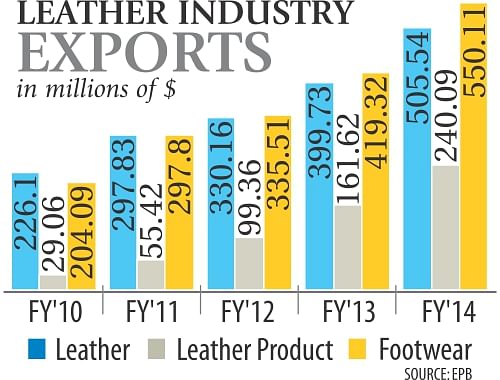Leather sector sees record exports
Leather sector sees record exports

The leather industry has set records for exports that soared 32.12 percent year-on-year to $1.29 billion in the immediate past fiscal year, according to Export Promotion Bureau.
Competitive prices and improved quality of Bangladeshi products that rope in more and more European and Japanese consumers and rising costs in China have led to the growth, exporters said.
Also, the earnings in fiscal 2013-14 were 6.59 percent higher than the target set at $1.21 billion for the sector.
Exports of leather goods rose 48.55 percent to $240.09 million during the period, while those of leather 26.47 percent to $505.54 million, and footwear 31.19 percent to $550.11 million, according to EPB data.
The leather industry earned $980.67 million in exports in fiscal 2012-13.
Exports would have been higher had there been no political unrest in the country, said Tipu Sultan, managing director of Bengal Leather Complex Ltd and Bengal Shoe Ltd that saw combined exports of around Tk 280 crore (around $36.1 million) last fiscal year.
“Many buyers are coming to Bangladesh as we offer quality products at competitive prices,” said M Abu Taher, chairman of Bangladesh Finished Leather, Leathergoods and Footwear Exporters' Association.
An increased number of buyers are diverting orders from China, where production costs have gone up significantly, he added.
Improved quality has helped in winning the confidence of buyers, said Aniruddah Kumar Roy, managing director of Footbed Footwear Ltd that exported products worth around Tk 200 crore (around $25.8 million) in fiscal 2013-14.
“We can now make quality products as skills of our labour force have improved much,” he said, adding that the garment sector has contributed to skills development in the leather industry.
Giving an example, Roy said footwear and leather goods require stitching and packaging, and for these jobs, skilled workers are available in the garment sector.
“We can hire workers from the garment sector,” Roy said.
China produces footwear of around $90 billion and leather goods of $39 billion a year, which account for 65 percent and 35 percent of the global demand respectively, according to Roy.
But the Asian economic giant is also facing a number of challenges such as anti-dumping tax imposed by the European Union and strengthening of renminbi by 20 percent against the dollar.
The Chinese government has recently asked their factory owners to provide pension and health schemes for workers, which Sultan of Bengal Leather said will ultimately increase its production costs further.
Price hike of Bangladeshi products is another reason behind the rise in export earnings, said Shaheen Ahmed, chairman of Bangladesh Tanners' Association.
“Many leather goods and footwear makers are offering high quality products targeting the middle- and high-end segments, which ultimately raises unit price,” he said.
Export price of crushed leather increased $0.10 each square foot on average, said Ahmed, also chairman of Kohinoor Tanneries Ltd.
Of the total exports from the leather industry, 60 percent go to the EU, 30 percent to Japan and 10 percent to the rest of the world, according to industry operators.
The leather industry, which has grown on local hides and skins, now emerges as the second largest export earner after garments.
Exports from the leather industry account for 4.29 percent of the total exports of $30.17 billion in fiscal 2013-14.
Bangladesh will be able to earn $16 billion in exports from leather, leather goods and footwear in the next decade if it can properly address health, environment and compliance issues in the sector, analysts said.